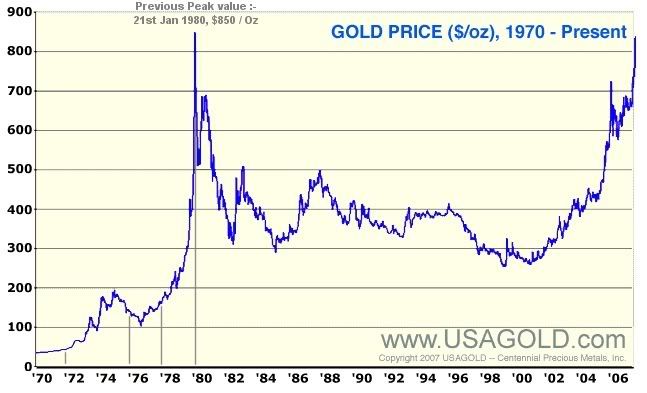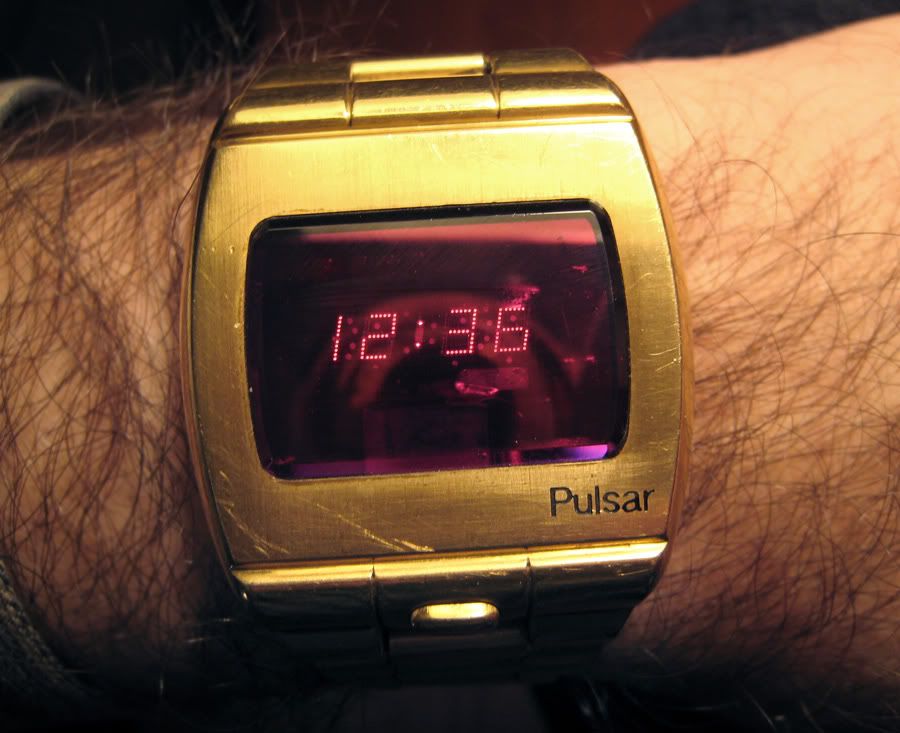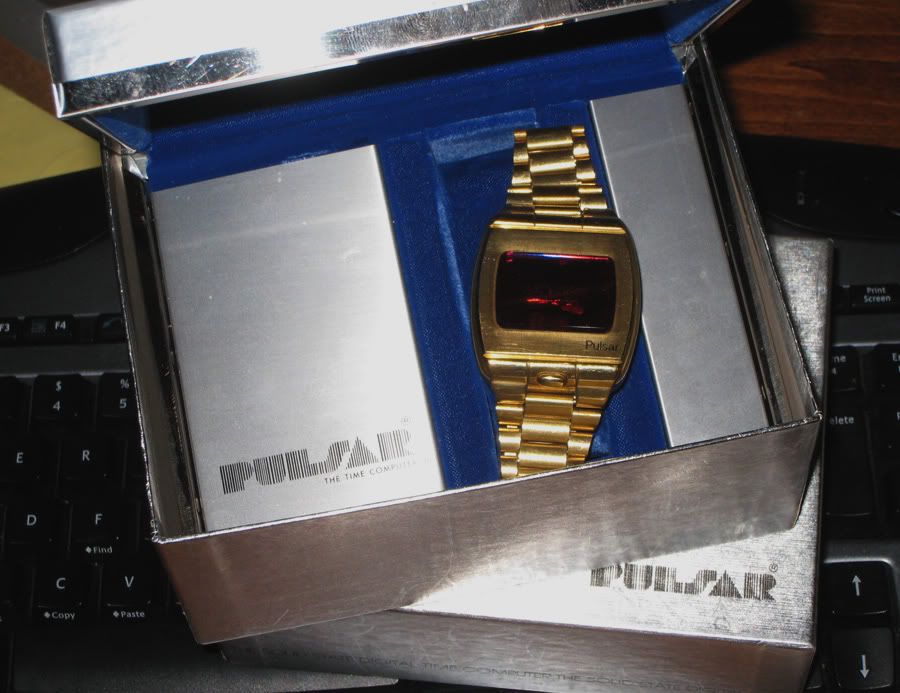I would like to present some additional material for the jury to consider.
This isn’t about taking sides, or passing judgement one way or the other, but it is an interesting debate. Whilst I doubt it can ever be resolved without 400 first hand witness statements, the evidence can be further enhanced based on facts and some direct personal recollections based on 33 years of buying digital watches.
Firstly, here's an interesting graph from the same source as above :-

I first lusted after LED’s in 1972, but wasn’t able to buy one until 1975 when the prices were plummeting. I started buying LCD’s in 1976, and just about every watch I bought from that era, I still own. I also bought stacks of digitals in 1979-80-81 and onwards … because they were CHEAP CHEAP CHEAP !!! No one wanted ordinary LED’s anymore, at that time.LCD was the way to go.
LED’s in particular were often to be seen collecting dust in pawn brokers windows and other 2nd hand goods shops. I know, I bought quite a few for £2 or £3 here and there. Including a few that are now worth 100 times those prices. Also, remember, in the UK at least, there was a heavy recession going on, and ‘old led’ watches were seen as useless ‘crap’ along with a hell of lot of other items, be it luxury cars or yachts or whatever.
I cannot say I ever specifically saw a solid 18k gold P1 in a window though (can anyone?). And I have no particular recollection of what gold Omega’s, Pulsars, Pateks etc etc were worth, but the general perception AT THE TIME was they were not appreciated as they are today, and there was no internet, or ebay etc, and mass collecting of ‘old stuff’ wasn’t anywhere near as common as it is now. I do believe the internet is massively responsible for the explosion of people collecting just about anything.
However, put your brain into 1980 mode, and don’t even think how the world has moved since. People then would have known that gold was only $40 to $45 in 1970/1, and then in 1980 its hit $850 at its peak, per troy ounce, on 21st January 1980.
So just imagine the temptation of seeing gold go up roughly 2,000 % ?? Yes, a 2,000% increase. As with any bubble, people fear that it will burst, and there is always a marginal number of people who will rush to exploit the bubble before it bursts, and there are plenty of other factors.
So, if ordinary LED’s were worth nothing in 1980, and someone had a luxurious 7 or 8 year old solid gold watch of any description, I bet there was a “marginal” number of people who really did fall for the greed factor – back then … because the watch had no obvious collectible market, but a very obvious gold weight value. How big that margin is will never be known. But below I present three ways of looking at this dilemma :-
POINT 1 – the greedy opportunist view
At the moment, a P1 is worth approximately 3 to 6 times its raw gold worth, and this is with easy collector communications using the net, and increased desirability through media exposure etc. If you scale that back to late 70’s, then “maybe” P1’s were worth $450-$900, ie 3 x $150 (1977). So it’s a very obvious temptation in 1980 to sell to an opportunist who offers you $1,000. That opportunist wouldn’t have wasted any time on sentimental collector feelings and would have ruthlessly run down to the local smelters to collect his $2,000 reward. (and with foresight he would have saved the module and sapphire for sale on ebay 28 yrs later!)
. . . .
POINT 2 – the intrinsic gold value argument
With LED’s price crashing through the floor due to the onslaught of LCDs in 1976/7, and with Pulsar going out of business at the same time because they couldn’t sell their luxury watches for more a couple of hundred, and with no strong collectors market or obvious route to market, I feel confident that Gold 18k watches would have been worth, say, 2 to 4 times their gold mass. In 1975 - 1976, gold averaged only $100 to $120 an ounce.
So using the same formula above for melt worth, a 4 oz P1 x $120 x 0.75, = $338… (1976)
If its 2nd hand value was say 2 to 3 times its weight value, that’s only $660 to $900. And remember the world was in recession, and there wasn’t an instant route to market for these things.
So when you find out your few hundred dollar gold watch is worth a whopping $2,000 melt value in 1980, I bet you a number of people didn’t think twice about melting them down. I don’t just mean Pulsars, but any other 18kt piece of jewellery, as well as unfashionable LED’s.
--------------------------------------------
POINT 3 – BASED ON FACTS
I have seen an older copy of the P1 owners list, as compiled by the Time Computer and it includes dates and prices paid. Without embarrassing anyone on the list, its worth pointing out 5 examples of P1 sales, just 10 year ago, in 1997- 1998. These were for $1,400, $1,500, $2,500, $2,600, $3,600.
(Some of these were in German marks so I used this historical dollar converter
http://www.oanda.com/convert/classic )
Generally speaking the values of collectibles rise over long time spans, subject to economic fluctuations and numerous other factors beyond the scope of these comments. With better communications its now possible for a tiny bunch of collectors to keep track of things. But in 1980 ?? I just don’t think there was much of a market at all, and therefore low demand, and not much to push the prices up and up like now.
I feel that using these old actual sales records, a P1 may well have been worth $1,500 or so in 1997, but in 1980 with the world recession going on, I bet it was a hell of lot less. So in 1980 with its gold mass worth $2,000, I bet many were tempted.
----
So in conclusion, I am certain quite a number of P1’s and other 18kt gold digitals went, sadly, to the melting pot. If 400 were originally made, and only about 30 or 40 are known to exist, with 4 or 5 changing hands on ebay per year with barely more than 1 or 2 new 'finds' per year, where did the other 80-85% of them go ???
.











